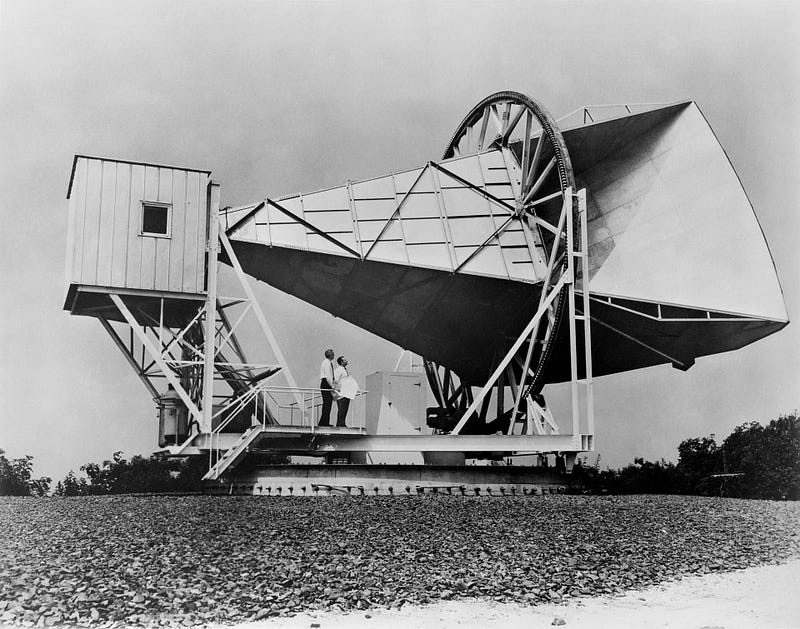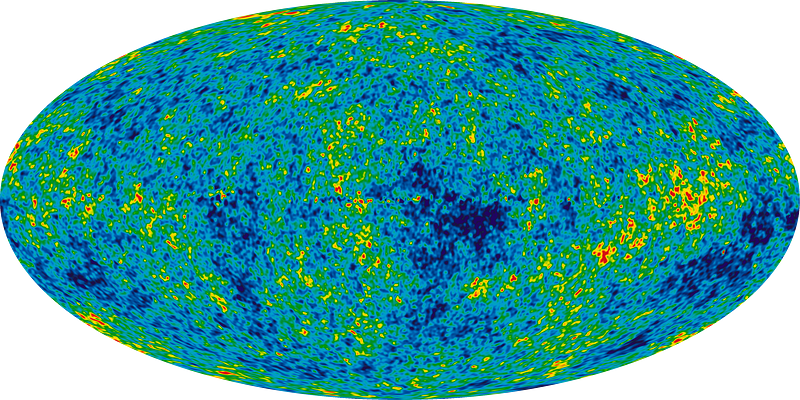The Surprising Origins of Cosmic Microwave Background Radiation
Written on
Chapter 1: The Unexpected Discovery
What was initially dismissed as mere pigeon droppings ultimately transformed our understanding of cosmology. Researchers thought that the noise emanating from their radio antenna was due to bird excrement. They cleaned the equipment and attempted to scare the birds away, but the mysterious noise persisted, echoing from all directions, day and night.
What was this incessant signal that, although originally attributed to pigeon waste, would dramatically alter the course of cosmological studies?

In 1964, at Bell Labs in New Jersey, Arno Penzias and Robert Wilson were tasked with detecting faint radio signals reflected by Echo Balloon satellites using their 9-meter Holmdel Horn Antenna. They meticulously worked to eliminate all potential noise sources from radars and radio broadcasts. To further reduce interference, they cooled the antenna with liquid helium. Yet, despite these efforts, an inexplicable noise persisted—a remnant of something monumental.
Penzias and Wilson were unaware of the significance of their findings until Bernard Burke from MIT informed them about a preprint by Robert Dicke, Jim Peebles, and David Wilkinson from Princeton University, who were actively searching for microwave radiation. What they had stumbled upon was the oldest light in the cosmos.
This phenomenon, occurring only 300,000 years post-Big Bang, allowed electrons and protons to combine into hydrogen atoms, producing photons that made the universe transparent to light for the first time. As the universe expanded, this relic of the Big Bang became fainter and shifted into the microwave spectrum. These microwaves are ubiquitous and represent the fossil radiation from an event that birthed our universe.
Chapter 1.1: Cosmic Microwave Background Radiation Unveiled
We now recognize this omnipresent noise as the cosmic microwave background radiation. These signals serve as compelling evidence for Big Bang cosmology and have effectively discredited alternate cosmological models. For their groundbreaking discovery, Penzias and Wilson received the Nobel Prize in 1978.
While the Big Bang theory has its challenges, it remains a vital framework for understanding our universe. Science thrives on self-correction, and we embrace this process.
How Pigeon Poop Helped Unlock the Universe's Secrets
This video explores the unexpected connection between pigeon droppings and groundbreaking discoveries in cosmology, shedding light on the cosmic microwave background radiation.
Chapter 1.2: The Role of Curiosity
The most significant lesson from this narrative is that genuine curiosity is paramount for achieving great scientific breakthroughs. Nature often surprises us, revealing profound truths that exceed our expectations, but this requires a passionate desire to explore.
Curiosity acts as our guiding light, urging us to pursue knowledge and uncover the mysteries that lie ahead. Sometimes, the results are more magnificent than we could ever anticipate.
Chapter 2: The Big Bang Theory Solidified
Prior to this pivotal discovery, the Big Bang theory was merely one of several competing hypotheses regarding the origins of the universe. The steady-state theory, which argued that the universe has always existed, was a formidable rival. The identification of cosmic microwave background radiation provided definitive evidence supporting the Big Bang theory, marking a significant turning point in cosmology.
Chapter 2.1: Implications for Modern Cosmology
The ramifications of this discovery were immense. It opened new pathways for research into the early universe, prompting scientists to analyze variations in the cosmic microwave background to glean insights about the universe's initial conditions. This investigation has led to a deeper understanding of its composition, structure, and evolution.
Detailed studies of the cosmic microwave background have revealed that ordinary matter constitutes only about 5% of the universe, with dark matter and dark energy making up the remainder. These revelations have revolutionized our comprehension of cosmology and sparked new inquiries into the universe's nature.

Chapter 2.2: The Pursuit of Knowledge
The work of Penzias and Wilson exemplifies the importance of curiosity and the relentless quest for knowledge. It illustrates how even seemingly trivial or persistent problems can lead to groundbreaking discoveries when approached with an open mind and a willingness to explore the unknown.
Their legacy inspires generations of scientists to think beyond the obvious and continuously question established ideas, fostering a culture of inquiry and innovation that propels scientific progress.
Chapter 3: Reflecting on the Journey
Looking back at the path from the initial discovery to the Nobel Prize, it is evident that the road to revelation is rarely straightforward. It involves meticulous research, serendipity, and an openness to unconventional ideas.
Penzias and Wilson's experience underscores the significance of collaboration in science. Without the exchange of ideas among researchers from diverse fields, the importance of their discovery might have gone unnoticed.
The story of cosmic microwave background radiation is not just a tale of scientific accomplishment; it serves as a powerful reminder of the wonders of the universe and the infinite possibilities that arise when we remain curious and receptive to new concepts.
How (a Lack of) Bird Poop Proved the Big Bang
This video delves into how the absence of bird droppings played a crucial role in confirming the Big Bang theory, illustrating the unexpected connections in scientific discovery.